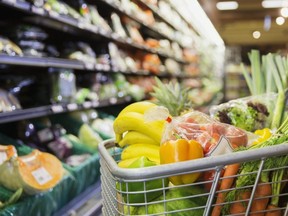Policymakers must create a more investor-friendly environment to attract new players and lower food prices for Canadians

Article content
In recent days, the Jim Pattison Group, which owns the Pattison Food Group and operates various retail banners such as Save-On-Foods and Buy-Low Foods, has made a significant move by acquiring The Save Mart Companies – a prominent grocer in California and Nevada.
Advertisement 2
Article content
This makes the Jim Pattison Group the second Canadian grocer to venture into the U.S., following Loblaw-owned T&T Supermarkets, which plans to open its first U.S. store in Bellevue, Washington, this year.
The Save Mart Companies serve nearly 200 communities under banners such as Save Mart, Lucky, Lucky California, FoodMaxx, and Maxx Value Foods. They operate extensive distribution centers and a transportation facility, employing over 13,000 people. For the Pattison Group, this acquisition will significantly expand its grocery network on both sides of the border.
However, while Canadian grocers are expanding into the U.S. market, there has been no reciprocal movement of foreign grocers entering Canada. Despite the efforts of Ottawa and Innovation Minister François-Philippe Champagne, who have approached a dozen grocers to enter the Canadian market, there have been no new entrants.
Article content
Advertisement 3
Article content
This situation raises concerns about the attractiveness of the Canadian market for foreign investment.
Recommended from Editorial
-

CHARLEBOIS: Grocery sticker shock no more — well, sort of
-

CHARLEBOIS: ‘Look-Smell-Taste’ — Canada’s recipe for reducing food waste
-

CHARLEBOIS: How heatwaves cook our grocery bills
Policymakers must recognize that competition is not created but nurtured.
The government’s role is to create conditions that make Canada an attractive place to invest. Currently, Canada faces challenges in this regard.
The GDP numbers released this week show that while the Canadian economy is growing, it is not keeping pace with the growing population. In 2023, according to Trading Economics, Canada’s GDP per capita was $61,849, compared to almost $89,000 in the United States. The U.S. GDP per capita grew by 3.3% in 2023, while Canada’s grew by only 0.6%. These figures do not inspire confidence that the Canadian economy can support new competitors.
Advertisement 4
Article content
Interprovincial barriers also pose significant challenges. Establishing a national distribution network in Canada is nearly impossible due to regulatory inconsistencies across provinces. For example, only five provinces, including Alberta, allow unrestricted alcohol transportation across provincial borders. In British Columbia, certain trucks can only operate at night, whereas in Alberta, they can only be driven during the day, limiting cross-border travel.
Moreover, different provinces have varying regulations on construction site toilet seats, and Quebec, Nova Scotia, and Newfoundland & Labrador restrict the export of live snow crabs, requiring in-province processing before export. Additionally, providing legal services in Manitoba often necessitates maintaining a physical office within the province.
Advertisement 5
Article content
RECOMMENDED VIDEO
According to the Business Council of Alberta, removing these barriers could increase national GDP by more than $80 billion (3.8%), boost average wages by at least 5%, and increase government revenues for social programs by more than 4%. It would also attract more investment to Canada and benefit Canadians through lower food prices by increasing domestic competition.
The optics of recent political actions are also problematic. Summoning CEOs for photo-ops and political posturing may generate headlines but it damages Canada’s reputation among potential investors. Actions by politicians like Jagmeet Singh have sent a message that, while Canada’s doors are open, making significant profits is unwelcome.
Advertisement 6
Article content
Furthermore, with capital gains tax increases on the horizon, the prospect of attracting foreign grocers like Aldi or Lidl to Canada seems even more remote. The best chance for Canadians to shop at these stores might be to cross the border into the U.S.
For Canada to attract foreign investment and enhance competition in its grocery sector, it must address regulatory inconsistencies, improve economic conditions, and present a more investor-friendly political climate. Only then can Canadian consumers hope to see the benefits of increased competition and lower prices.
Article content









